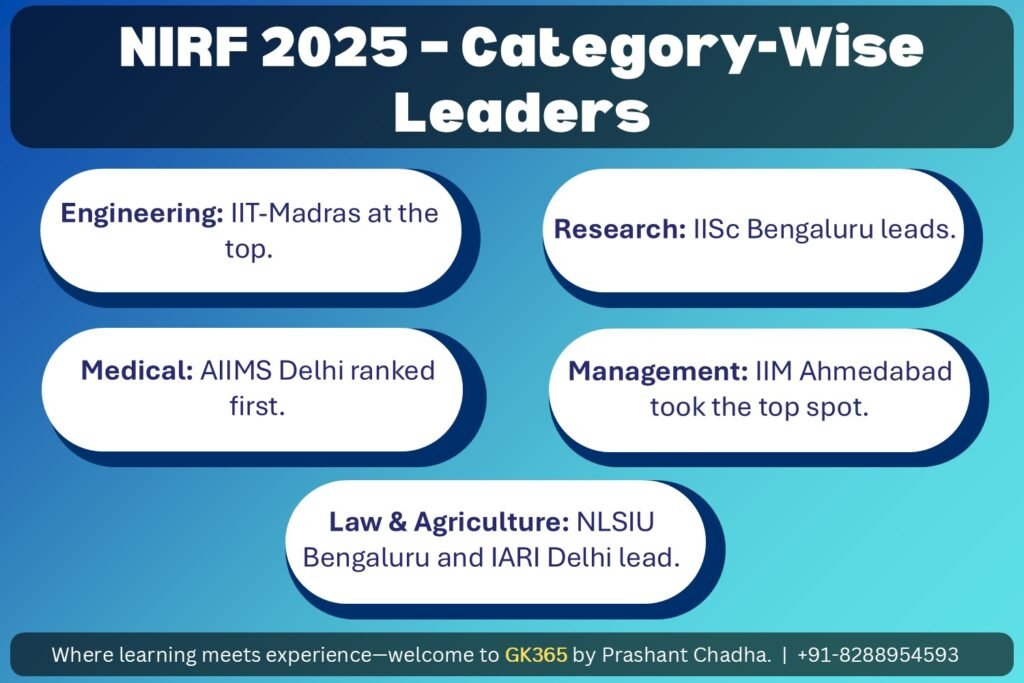IIT-Madras Tops NIRF Rankings 2025 for Seventh Consecutive Year
Table of Contents
- Introduction
- Background of NIRF
- Overall Top Performers
- Category-Wise Highlights
- Key Highlights from the Education Minister’s Statement
- Ranking Parameters Explained
- Significance of NIRF Rankings
- The Journey of IIT-Madras at the Top
- Growing Competition Among Institutions
- Challenges in Indian Higher Education
- Looking Ahead: NIRF and Viksit Bharat 2047
- Conclusion
- Key Takeaways Table
Introduction
On September 4, 2025, the Ministry of Education released the 10th National Institutional Ranking Framework. IIT-Madras again led the overall list. This marks its seventh straight year at No. 1. The rankings track progress across 17 categories and show steady competition in higher education.
Background of NIRF
The Ministry launched NIRF in 2015. It set a clear and uniform yardstick for Indian institutions. Over ten years, it has become a common reference for teaching quality, research output, inclusion, and public image.
The 2025 list closes a decade of the exercise. More institutions took part, so comparisons across fields grew deeper.
Overall Top Performers
- 1st: IIT-Madras
- 2nd: IISc Bengaluru
- 3rd: IIT-Mumbai
IIT-Madras shows strength in teaching, research, and innovation. IISc leads in pure research. IIT-Mumbai reinforces its status as a top engineering and innovation hub.
Category-Wise Highlights
Engineering
- IIT-Madras ranked first.
- IIT-Delhi placed second.
Innovation
- IIT-Madras ranked first in Innovation. It leads on startups, patents, and tech transfer.
Research Institutions
- IISc Bengaluru held the top spot.
Medical and Dental
- AIIMS Delhi led the field.
Law
- National Law School of India University, Bengaluru ranked first.
Agriculture
- Indian Agriculture Research Institute, Delhi took the top rank.
Management
- IIM Ahmedabad ranked first.
- IIM Bangalore and IIM Kozhikode placed second and third.
Pharmacy
- Jamia Hamdard, New Delhi ranked first.
- BITS Pilani ranked second. Panjab University placed third.
Architecture and Planning
- IIT-Roorkee ranked first.
- NIT Kozhikode and IIT-Kharagpur followed.
Colleges
- Hindu College, University of Delhi ranked first.
- Miranda House ranked second. Hansraj College ranked third.
State Public Universities
- Jadavpur University, Kolkata ranked first.
- Anna University, Chennai ranked second.
Open Universities
- IGNOU, Delhi led the category.
Skill Universities
- Symbiosis Skills and Professional University drew special mention for skill-focused training.
Sustainable Development Goals (SDGs)
- New category in 2025.
- IIT-Madras ranked first for SDG-linked work and sustainability.
Key Highlights from the Education Minister’s Statement
Education Minister Dharmendra Pradhan tied the exercise to “Viksit Bharat 2047”. He called for “One Nation, One Data” to improve consistency and transparency. He also proposed adding entrepreneurship as a future metric. That would reduce heavy weight on perception and reward job creation and startups.
Ranking Parameters Explained
NIRF uses five core measures:
- Teaching, Learning, and Resources (TLR): Faculty, facilities, and the learning setup.
- Research and Professional Practice (RP): Publications, patents, and research volume.
- Graduation Outcomes (GO): Results, placements, and higher studies.
- Outreach and Inclusivity (OI): Gender balance, regional spread, and social reach.
- Perception (PR): Reputation among peers, employers, and the public.
Significance of NIRF Rankings
Students and families use these ranks to compare options. Recruiters read them to plan hiring. High-ranked institutions draw more applications and funding. They also build stronger links with industry.
What does this mean for applicants? They can judge teaching and research on common metrics. That cuts guesswork.
The Journey of IIT-Madras at the Top
IIT-Madras has stayed No. 1 through a broad base of work:
- Leading engineering and innovation programs.
- India’s first 5G testbed and other advanced centers.
- Strong startup and incubation support.
- Growth in sustainability and renewable energy projects.
The new SDG category in 2025 highlights its focus on work with social impact.
Growing Competition Among Institutions
IIT-Madras leads, and the gap is narrowing. Other IITs and IISc push hard on research and labs. IIMs hold firm in management. State and private players, such as Jadavpur University and Jamia Hamdard, excel in niche areas.
Challenges in Indian Higher Education
- Shortage of faculty in many public universities.
- Research funds cluster at a few top campuses.
- Urban–rural access gaps remain.
- International links need a wider base to lift global ranks.
Looking Ahead: NIRF and Viksit Bharat 2047
The aim for 2047 is a strong global knowledge hub. NIRF will help track that path with clear numbers. A shift to “One Nation, One Data” will improve data quality. If entrepreneurship enters the score, campuses may back startups, labs, and jobs even more.
Conclusion
NIRF 2025 again places IIT-Madras at the top in the overall list. The rankings reflect breadth across fields, from IISc in research to AIIMS in medicine and IIM Ahmedabad in management. The SDG category signals rising focus on sustainability. As India works toward Viksit Bharat 2047, these ranks offer both a mirror and a map.
Key Takeaways Table
| Aspect | Details |
|---|---|
| Top Overall Performer | IIT-Madras (No. 1 for 7 years) |
| Runner-ups | IISc Bengaluru (2nd), IIT-Mumbai (3rd) |
| New Category | Sustainable Development Goals (SDGs) – IIT-Madras ranked 1st |
| Category Leaders | AIIMS Delhi (Medical), IIM Ahmedabad (Management), IISc Bengaluru (Research) |
| Education Minister’s Key Point | “One Nation, One Data” for consistency & transparency |
| Ranking Parameters | Teaching & Learning, Research, Graduation Outcomes, Outreach & Inclusivity, Perception |
| Significance | Helps students, recruiters, and policymakers compare institutions on clear metrics |



